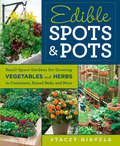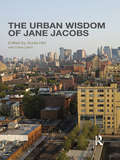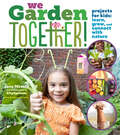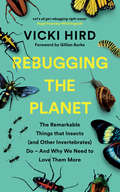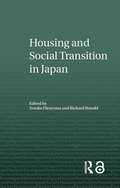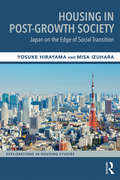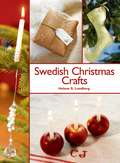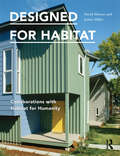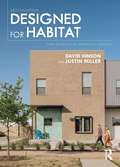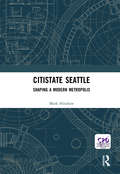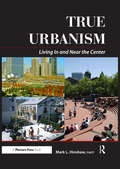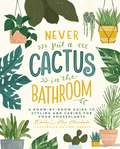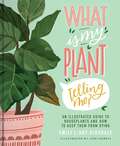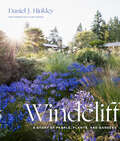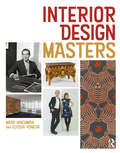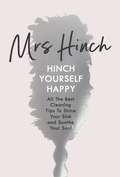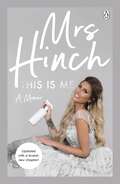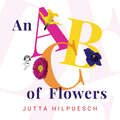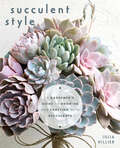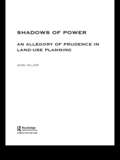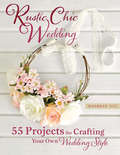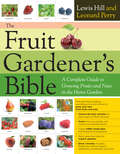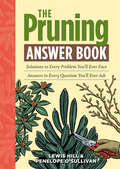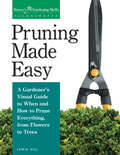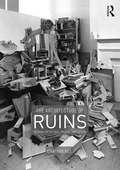- Table View
- List View
Edible Spots and Pots: Small-Space Gardens for Growing Vegetables and Herbs in Containers, Raised Beds, and More
by Stacey HirvelaIt's time for home gardeners to rethink the traditional garden and explore the wide variety of options for growing edibles in "anywhere" gardens—from decorative pots and raised beds to unusual growing bags, hanging pouches, and tomato rings. These contained gardens are more manageable than long rows or plots and require much less work—yet yield just as much bounty.Featuring dozens of preplanned planting recipes, based on space or container sizes, Edible Spots and Pots allows readers to mix and match vegetables, herbs, small fruits, and edible flowers to create a plant-style patchwork based on the "thriller" (dramatic, focal-point plants), "filler" (midheight, bushy plants), and "spiller" (vines and twining plants) formula for creating interesting and botanically sound gardens. Plot-free gardening offers practical solutions for any circumstance a gardener may encounter (challenging spaces, soils, or weather), while also taking into account budget, time, and aesthetic goals.Author Stacey Hirvela shares many other interesting concepts, like One-Minute Veggies (foods that go from patio to plate in less than a minute) Doubly Delicious Crops that give two flavors from one plant, and space/yield ratios (vegetables worth their footprint). Gardeners will also find an enticing array of 60 edibles that grow well in a defined space for productivity and beauty.
The Urban Wisdom of Jane Jacobs (Planning, History and Environment Series)
by Sonia Hirt Diane ZahmHere for the first time is a thoroughly interdisciplinary and international examination of Jane Jacobs’s legacy. Divided into four parts: I. Jacobs, Urban Philosopher; II. Jacobs, Urban Economist; II. Jacobs, Urban Sociologist; and IV. Jacobs, Urban Designer, the book evaluates the impact of Jacobs’s writings and activism on the city, the professions dedicated to city-building and, more generally, on human thought. Together, the editors and contributors highlight the notion that Jacobs’s influence goes beyond planning to philosophy, economics, sociology and design. They set out to answer such questions as: What explains Jacobs’s lasting appeal and is it justified? Where was she right and where was she wrong? What were the most important themes she addressed? And, although Jacobs was best known for her work on cities, is it correct to say that she was a much broader thinker, a philosopher, and that the key to her lasting legacy is precisely her exceptional breadth of thought?
We Garden Together!: Projects for Kids: Learn, Grow, and Connect with Nature
by Jane Hirschi Educators at City SproutsThis colorful activity book invites kids ages 3 to 6 to explore the world of plants and how they grow through creative hands-on activities developed by City Sprouts, a leading educational organization focused on introducing urban kids to the wonders of the garden and promoting equity in science education.
Rebugging the Planet: The Remarkable Things that Insects (and Other Invertebrates) Do – And Why We Need to Love Them More
by Vicki Hird"This is a lovely little book that could and should have a big impact...Let’s all get rebugging right away!"—Hugh Fearnley-Whittingstall Meet the intelligent insects, marvelous minibeasts, and inspirational invertebrates that help shape our planet—and discover how you can help them help us by rebugging your attitude today! Remember when there were bugs on your windshield? Ever wonder where they went? We need to act now if we are to help the insects survive. Robin Wall Kimmerer, David Attenborough, and Elizabeth Kolbert are but a few voices championing the rewilding of our world. Rebugging the Planet explains how we are headed toward “insectageddon” with a rate of insect extinction eight times faster than that of mammals or birds, and gives us crucial information to help all those essential creepy-crawlies flourish once more. Author Vicki Hird passionately demonstrates how insects and invertebrates are the cornerstone of our global ecosystem. They pollinate plants, feed birds, support and defend our food crops, and clean our water systems. They are also beautiful, inventive, and economically invaluable—bees, for example, contribute an estimated $235 to $577 billion to the US economy annually, according to Forbes. Rebugging the Planet shows us small changes we can make to have a big impact on our littlest allies: Learn how to rewild parks, schools, sidewalks, roadsides, and other green spaces. Leave your garden to grow a little wild and plant weedkiller-free, wildlife-friendly plants. Take your kids on a minibeast treasure hunt and learn how to build bug palaces. Make bug-friendly choices with your food and support good farming practices Begin to understand how reducing inequality and poverty will help nature and wildlife too—it’s all connected. So do your part and start rebugging today! The bees, ants, earthworms, butterflies, beetles, grasshoppers, ladybugs, snails, and slugs will thank you—and our planet will thank you too.
Housing and Social Transition in Japan (Housing and Society Series)
by Yosuke Hirayama Richard RonaldBringing together a number of perspectives on the Japanese housing system, Housing and Social Transition in Japan provides a comprehensive, challenging and theoretically developed account of the dynamic role of the housing system during a period of unprecedented social and economic change in one of the most enigmatic social, political, and economic systems of the modern world. While Japan demonstrates many of the characteristics of some western housing and social systems, including mass homeownership and consumption-based lifestyles, extensive economic growth and rapid urban modernization has been achieved in balance with traditional social values and the maintenance of the family system. Helpfully divided into three sections, Housing and Social Transition in Japan: explores the dynamics of the development of the housing system in post-war Japan deals with social issues related to housing in terms of social aging, family relations, gender and inequality addresses the Japanese housing system and social change in relation to comparative and theoretical frameworks. As well as providing challenges and insights for the academic community at large, this book also provides a good introduction to the study of Japan and its housing, economic, social and welfare system generally.
Housing in Post-Growth Society: Japan on the Edge of Social Transition (Explorations in Housing Studies)
by Yosuke Hirayama Misa IzuharaIn a globalising world, many mature economies share post-growth characteristics such as low economic growth, low fertility, declining and ageing of the population and increasing social stratification. Japan stands at the forefront of such social change in the East Asian region as well as in the Global North. It is in this context of ‘post-growth society’ that housing issues are examined, using the experiences of Japan at the leading edge of social transition in the region. The post-war housing system was developed during the golden age of economy and welfare, when upward social trajectories such as increasing population, high-speed economic growth with rising real incomes, housing construction driven by high demands, increasing rates of home ownership supported by generous government subsidies generated new housing opportunities and accompanying issues. As we have entered the post-growth phase of socio-economic development, however, it requires a re-examination of such structure, policy and debates. This volume explores what roles housing plays in the reorganisation and reconstruction of economic processes, social policy development, ideology and identity, and intergenerational relations. The volume offers a greater understanding of the characteristics of post-growth society – changing demography, economy and society – in relation to housing. It considers how a definitive shift to the post-growth period has produced new housing issues including risks as well as opportunities. Through analysis of the impact on five different areas: post-crisis economy, urban and regional variations, young adults and housing pathways, fertility and housing, and ageing and housing wealth, the authors use policy and institutions as overarching analytical tools to examine the contemporary housing issues in a post-growth context. It also considers any relevance from the Japanese experiences in the wider regional and global context. This original book will be of great interest to academics and students as well as policy makers and practitioners internationally in the fields of housing studies, urban studies, social policy, sociology, political economy, comparative analysis, and East Asian Studies.
Swedish Christmas Crafts
by Annika S. Hipple Helene S. LundbergStraight from a country famous for its Christmas celebrations, Swedish author Helene Lundberg goes into detail on everything necessary to make beautiful Christmas crafts with an authentic Swedish twist. This full-color book includes lists of necessary materials, step-by-step pictures of each project, and patterns in the back of the book so you get perfect results with every craft. From stockings, ornaments, and picture frames to creative gift wrappings, Christmas cards, and homemade candles, the simple and elegant projects in this book are easy enough to appeal to beginners, but exquisite enough to make even the newest crafter seem like an expert.
Designed for Habitat: Collaborations with Habitat for Humanity
by David Hinson Justin MillerIf you're looking for ways to give back to your community, then this book, the first to profile thirteen projects designed and built by architects and Habitat for Humanity, will help. Detailed plans, sections, and photographs show you how these projects came about, the strategies used by each team to approach the design and construction process, and the obstacles they overcame to realize a successful outcome. The lessons and insights, presented here will aid you, whether you're an architect, architecture student, Habitat affiliate leader, or an affordable housing advocate. Located all across the United States, these projects represent the full spectrum of Habitat for Humanity affiliates, from large urban affiliates to small rural programs. These cases illustrate a broad range of innovative approaches to energy performance, alternative construction strategies, and responses to site context. And each house demonstrates that design quality need not fall victim to the rigorous imperatives of cost, delivery, and financing.
Designed for Habitat: New Directions for Habitat for Humanity
by David Hinson Justin MillerDesigned for Habitat: New Directions for Habitat for Humanity presents 12 new projects designed and built via collaborations between architects and Habitat for Humanity®. The ways in which we think about affordable housing are being challenged by designers and not-for-profit housing advocates such as Habitat for Humanity and its affiliates. The projects chronicled in this book consider home affordability through the lens of monthly homeownership expenses, energy efficiency and residential energy use, and issues of designed resilience to natural events ranging from aging and accessibility concerns to natural disasters and climate change. New to this edition, the projects reflect new approaches to building scale, construction technology, energy and affordability, and design and context. Illustrated with over 100 color images, the case studies include detailed plans and photographs to show how these projects came about, the strategies used by each team to approach the design and construction process, and the obstacles they overcame to realize a successful outcome. The lessons and insights presented will be a valuable resource, whether you’re an architect, an architecture student, a Habitat affiliate leader, or an affordable housing advocate.
Citistate Seattle: Shaping A Modern Metropolis
by Mark HinshawWith style and humor, the author writes of special places in everyday Seattle. The author takes us to popular, high-profile landmarks like Pike Place Market as well as tucked-away gems — cozy cottages, trendy pubs, gracious apartment buildings, and vibrant urban villages — that flavor and enliven the city. The author shares his eye for unique, humanizing details of design, architecture, and function, bringing this colorful metropolis to life so vividly you'll practically smell the coffee they brew and sell on (almost) every street corner. Along the way, the author explains the public and private decisions that helped Seattle avoid the urban desolation that plagues other American cities. The author introduces many of Seattle's movers and shakers — mayors, developers, artists, and urban pioneers — who took it upon themselves to guide metropolitan Seattle along a different path.
True Urbanism: Living In and Near the Center
by Mark HinshawMark Hinshaw has a proposition for Americans: Come out of the bunker, throw open the gates, and meet the neighborhood. In this passionate appeal, he introduces those who have already done just that and explains what cities can do to make true urbanism possible. He rejoices in the growing number of people rejecting sterile, paint-by-numbers subdivisions in favor of vibrant and unpredictable urban neighborhoods. This vivid account of cities small and large emerging from the cobwebs of late 20th century development will show communities with lingering antiurban tendencies how to embrace density as destiny. A must-read urban design book for anyone who cares about cities.
Never Put a Cactus in the Bathroom: A Room-by-Room Guide to Styling and Caring for Your Houseplants
by Emily L. HinsdaleFuel your houseplant obsession with this beautifully illustrated room-by-room guide to bringing the outdoors inside—perfect for plant parents everywhere!Millions of plant lovers and newbie gardeners are discovering the joys of bringing plants into their homes. Not only do they add a fresh, natural touch to any room, they also have serious mood-boosting power, and help to reduce stress, improve air quality, and even provide fresh herbs for that next meal! It&’s a no-brainer that houseplants can improve our quality of life—but how do you maximize their benefits without sacrificing style. Full of home design and practical plant care tips as well as more than 70 plant recommendations, Never Put a Cactus in the Bathroom is an illustrated guide to help you choose the right plants for your space, from succulents and spider plants to pothos and ZZ plants. A Houseplant 101 section will set you off on the right foot, covering essentials of plant care and maintenance, as well as basic troubleshooting, and a primer on the health benefits of indoor plants. Then, going room by room, you will find space-specific recommendations, such as: -Purifying the air in your bedroom with low light beauties -Decorating your bathroom with air plants and ferns—your shower powers the climate is they need to thrive! -Creating a living centerpiece for your dining room or breakfast nook -Adding a low-maintenance bamboo or jade plant to your home office for motivation and focus -Growing a windowsill herb box or hydroponic tomato to level up your next meal Perfect for fans of Wild at Home, Urban Jungle, and Wellness by Design, this book will give plant lovers the tools and confidence they need to bring houseplants into every corner of their homes, improve their quality of life, and turn their home into a natural sanctuary.
What Is My Plant Telling Me?: An Illustrated Guide to Houseplants and How to Keep Them Alive
by Emily L. HinsdaleKeep your house plants alive and thriving with this illustrated, accessible guide to popular house plants for new and experienced plant-parents alike.Many new gardeners are finally starting to understand why bringing the outside indoors is so appealing. From improving home décor to mental health, plants have so many benefits. But keeping them alive (and most importantly, thriving) isn&’t always easy! What does it mean if your plant has brown tips? Rotting roots? Yellow leaves? The list goes on. Don&’t you just wish your plants could communicate what&’s wrong and how to fix it? What Is My Plant Telling Me? answers all your plant-based questions making it the perfect companion for anyone interested in keeping their plants looking their best. This illustrated guide to the fifty most popular house plants will show you how to: -Speak your plant&’s language -Identify classic distress signals -Intervene successfully to keep your plants thriving for years to come -Choose plants that work best for your space -Pick the best locations within your home to keep your new plants -Identify the pot size needed when you want to replant -And more! Whether you&’re interested in growing a cactus, orchid, or even the popular Fiddle Leaf Fig, this book is the perfect guide to deciphering the message your plant is telling you and what you can do to revive it.
Windcliff: A Story of People, Plants, and Gardens
by Daniel J. Hinkley&“Dan Hinkley is a rare man, generous, inspired, and gifted with an eye for beauty that is given to few people. How I long to wander again in the galloping beauty of his garden at Windcliff. Here it is, in all its inspiring wonder.&” —Anna Pavord, author of Landskipping and The Curious GardenerDaniel Hinkley is widely recognized as one of the foremost modern plant explorers and one of the world&’s leading plant collectors. He has created two outstanding private gardens—Heronswood and Windcliff. Both gardens, and the story of how one begat the other, are beautifully celebrated in Hinkley&’s new book, Windcliff.In these pages you will delight in Hinkley&’s recounting of the creation of his garden, the stories of the plants that fill its space, and in his sage gardening advice. Hinkley&’s spirited ruminations on the audacity and importance of garden-making—contemplations on the beauty of a sunflower turning its neck from dawn to dusk, the way a plant&’s scent can spur a memory, and much more—will appeal to the hearts of every gardener.Filled with Claire Takacs&’s otherworldly photography, Windcliff is spectacular for both its physical beauty and the quality of information it contains.
Interior Design Masters
by Mark Hinchman Elyssa YonedaInterior Design Masters contains 300 biographical entries of people who have significantly impacted design. They are the people, historical and contemporary, that students and practitioners should know. Coverage starts in the late Renaissance, with a focus on the twentieth and twenty-first centuries. The book has five sections, with the entries alphabetical in each, so it can serve as a history textbook and a reference guide. The seventeeth- and eighteenth-century section covers figures from Thomas Chippendale to Horace Walpole. The nineteenth-century section includes William Morris and Candace Wheeler. The early twentieth-century section presents modernism’s design heroes, including Marcel Breuer, Eileen Gray, and Gilbert Rohde. The post-World War II designers range from Madeleine Castaing to Raymond Loewy. The final contemporary section includes Ron Arad and the Bouroullec brothers. These are the canonical figures who belong to any design history. The book also contains less well-known figures who deserve attention, such as Betty Joel, the British art deco furniture designer; Paul Veysseyre, the Frenchman active in China in the 1930s; and more recently Lanzavecchia-Wai, the Italian-Singaporean duo whose work ranges from health care to helicopters. Global in its coverage, the book is richly illustrated with over 600 black-and-white and color photographs.
Hinch Yourself Happy: All The Best Cleaning Tips To Shine Your Sink And Soothe Your Soul
by Mrs HinchStart the new year with a clean house and a calm mind with Mrs Hinch's very best cleaning tipsTHE NUMBER ONE SUNDAY TIMES BESTSELLER FROM THE INSTAGRAM SENSATION'Will not only help you transform your home and make it sparkle, but also show you how cleaning can soothe anxiety and stress' BEST BOOKS TO HELP YOU ORGANISE YOUR HOME IN 2020, MAIL ONLINE ______________'The sensation' Sun'We're made about Mrs Hinch' Vogue_______Cleaning - aka hinching - doesn't have to be that job you dread, not when Mrs Hinch is here to show you her sparkly ways.At over 3 million followers and counting, she has taken the nation by storm with her infectiously addictive charm, clever tidying tips and passionate belief in cleaning. Mrs Hinch invites you into her home and while inside you'll discover how a spot of cleaning is the perfect way to cleanse the soul. She'll even share the story of Mr and Mrs Hinch and their 'dorgeous' boy, Henry.Inside you'll find out:- How cleaning can soothe anxiety and stress- Mrs Hinch's must-haves- Step-by-step guides to hinching your home - And so much more! With the help of her cloth family, Mrs Hinch will help you turn your house into a home. Whether you're a daily duster or looking for a monthly makeover, Hinch Yourself Happy shows you how to create not only a cleaner house, but a calmer you.If you want your kitchen to sparkle like Meghan Markle, then this is the book for you.'Doing for household chores what Marie Kondo did for tidying. A step-by-step guide to achieving a spotless and immaculately tidy home' Daily Mirror'My new cleaning goddess' Daily Telegraph
This Is Me: The No 1 Sunday Times Bestseller
by Mrs HinchGet to know the woman behind the Instagram cleaning sensation, Mrs Hinch, in her fascinating and remarkably honest memoir*** FEATURING A BONUS CHAPTER ABOUT THE BIRTH OF LENNIE ***THE SUNDAY TIMES NO. 1 BESTSELLER'Gut-wrenchingly honest' The Mail on Sunday'I love that woman so much, she is just so great' Rylan Clark-Neal, BBC Radio 2_____________I sometimes can't believe just how much has happened in the last couple of life-changing years. It's been a total whirlwind of a journey, and I'm so grateful to all my followers for their amazing love and support along the way.From my very first toy kitchen which was my pride and joy right through to the my very first Instagram posts stories of my cleaning routine, I'm going to take you back to the start of how it all began. But there is so much more to my story than just cleaning tips; there have been the highest of highs, but also heart-breaking devastating lows.So let's do this! Put your Hinch Lists to one side, get comfy and join me on the sofa with a cuppa. Welcome to my world.This is me: Soph - the wife, the mother and the person behind Mrs Hinch._____________'The sensation' Sun'We're mad about Mrs Hinch' Vogue'My new cleaning goddess' Daily Telegraph'Doing for household chores what Marie Kondo did for tidying' Daily Mirror'Mrs Hinch offers a reassuring structure for the day, a vision of domestic order' Guardian
An ABC of Flowers
by Jutta Hilpuesch"A vividly photographed ABC book with a clean, sophisticated aesthetic." --Publishers WeeklyStep into the garden and learn your ABC's with this colorful feast for the eyes! From asters and daisies to roses and sunflowers, An ABC of Flowers is a colorful burst from the garden that will have little hands eager to grab. Filled with gorgeous photo illustrations, bold colors, and clever line art featuring a miniature-sized girl named Amelie, toddlers will laugh and be mezmerized by the book's vibrant pages.Perfect for the youngest readers learning their ABC's!
Succulent Style: A Gardener's Guide to Growing and Crafting with Succulents
by Julia HillierThe Ultimate Succulents Book for Gardeners and Crafters#1 New Release in Cacti & Succulents, Ornamental Plants, Gardening, Horticulture, and LandscapeWe know —killing your plants succs. A crash course on all things succulents, this engaging and easy-to-use succulents book offers everything you need to know so you can both successfully grow these gorgeous plants and create cool crafts with them, too. You’ll find everything you need to know from cacti plant care to specific projects for decorating with plants.A go-to reference for anyone trying to grow and maintain succulents. The ultimate guide to propagating, growing, and styling succulents and cacti both indoors and out, Succulent Style is as informative as it is gorgeous. Designed for millennials who want to stop killing their plants and for DIY types who want to learn about designing with succulents, Succulent Style is full of succulent growing techniques for beginners as well as for knowledgeable gardeners looking to expand their gardening skills. This beautifully photographed compendium makes the perfect addition to any coffee table or bookshelf.Succulent ideas for your home and garden. Whether you want to learn how to care for a cactus indoor or how to style plants, you’ll find tons of tips and tricks inside. Start designing succulents with fun projects like succulent garlands, wall art, wreaths, succulent bouquets, potted arrangements as well as many other cool things.Inside, you’ll also find:A detailed compilation of succulent varietiesInstructions on how to propagate and plant cacti and succulentsTips to integrate succulents into outdoor and indoor designIf you’re looking for a succulents plants book or cactus book —like A Beginner's Guide to Succulent Gardening, Essential Succulents, The Gardener's Guide to Succulents, or Cacti and Succulents Handbook —then you’ll love Succulent Style.
Shadows of Power: An Allegory of Prudence in Land-Use Planning (RTPI Library Series)
by Jean HillierShadows of Power examines public policy and in particular, the communicative processes of policy and decision-making. It explore the important who, how and why issues of policy decisions. Who really takes the decisions? How are they arrived at and why were such processes used? What relations of power may be revealed between the various participants?Using stories from planning practices, this book shows that local planning decisions, particularly those which involve consideration of issues of 'public space' cannot be understood separately from the socially constructed, subjective territorial identities, meanings and values of the local people and the planners concerned. Nor can it be fully represented as a linear planning process concentrating on traditional planning policy-making and decision-making ideas of survey analysis-plan or officer recommendation-council decision-implementation. Such notions assume that policy-and decision-making proceed in a relatively technocratic and value neutral, unidirectional, step-wise process towards a finite end point. In this book Jean Hiller explores ways in which different values and mind-sets may affect planning outcomes and relate to systemic power structures. By unpacking these and bring them together as influences on participants' communication, she reveals influences at work in decision-making processes that were previously invisible.If planning theory is to be of real use to practitioners, it needs to address practice as it is actually encountered in the worlds of planning officers and elected representatives. Hillier shed light on the shadows so that practitioners may be better able to understand the circumstances in which they find themselves and act more effectively in what is in reality a messy, highly politicised decision-making process.
Rustic Chic Wedding: 55 Projects for Crafting Your Own Wedding Style
by Morgann HillRustic Chic Wedding is a bride and groom's peek into the vintage-inspired, timeless wedding of their dreams. A little DIY with a whiff of romance and whimsy goes a long way toward wedding-day magic.Choose from any of the three beautiful wedding "themes.” Maybe your wedding style is Shabby Vintage Couture Wedding: try the Garden Table Numbers or Monogrammed Cake Stand. Or if the Rustic, Recycled & Re-purposed Wedding is more your speed, there's a Flower Girl Crown and Kissing Bell. The Urban Farmhouse Wedding has instructions for creating a Twig Cake Topper and a S'mores Bar. However you mix and match the projects, your wedding will express your love story, inside and out!With a chapter on creating the perfect themed tablescape and one dedicated to beautiful bridal bouquets and boutonnieres, Rustic Chic Wedding will be an indispensable guide on the sweetest day of your life..
The Fruit Gardener's Bible: A Complete Guide to Growing Fruits and Nuts in the Home Garden
by Lewis Hill Leonard PerryEnjoy bushels of crispy apples and baskets of juicy blueberries from your own backyard. Authors Lewis Hill and Leonard Perry provide everything you need to know to successfully grow delicious organic fruit at home, from choosing the best varieties for your area to planting, pruning, and harvesting a bountiful crop. With tips on cultivating strawberries, raspberries, grapes, pears, peaches, and more, this essential reference guide will inspire year after year of abundantly fruitful gardening.
The Pruning Answer Book: Solutions to Every Problem You'll Ever Face; Answers to Every Question You'll Ever Ask (Answer Book Ser.)
by Lewis Hill Penelope O'SullivanWhen should you prune a blackberry bush? How much should you remove? What’s the difference between pinching and heading back? And how can you be sure that you aren’t harming your fragile blossoms? The Pruning Answer Book offers fresh insights to these relevant questions and scores of others. With clear instructions, detailed illustrations, and expert advice, you’ll have all the information you need to successfully prune flowering plants, fruit and nut trees, shrubs, brambles, evergreens, vines, groundcovers, and more.
Pruning Made Easy: A Gardener's Visual Guide to When and How to Prune Everything, from Flowers to Trees
by Lewis HillProper pruning will keep your landscape beautiful and thriving year after year. This authoritative guide includes more than 300 step-by-step illustrations to clearly demonstrate the correct pruning procedures for a variety of trees, shrubs, hedges, vines, and flowers. Lewis Hill offers expert advice on when, how, and why each type of plant should be pruned, safety considerations, and techniques for maintaining your pruning tools. Encouraging you to get creative, Hill even shows you how to shape your own topiaries and train espaliers.
The Architecture of Ruins: Designs on the Past, Present and Future
by Jonathan HillThe Architecture of Ruins: Designs on the Past, Present and Future identifies an alternative and significant history of architecture from the sixteenth century to the twenty-first century, in which a building is designed, occupied and imagined as a ruin. This design practice conceives a monument and a ruin as creative, interdependent and simultaneous themes within a single building dialectic, addressing temporal and environmental questions in poetic, psychological and practical terms, and stimulating questions of personal and national identity, nature and culture, weather and climate, permanence and impermanence and life and death. Conceiving a building as a dialogue between a monument and a ruin intensifies the already blurred relations between the unfinished and the ruined and envisages the past, the present and the future in a single architecture. Structured around a collection of biographies, this book conceives a monument and a ruin as metaphors for a life and means to negotiate between a self and a society. Emphasising the interconnections between designers and the particular ways in which later architects learned from earlier ones, the chapters investigate an evolving, interdisciplinary design practice to show the relevance of historical understanding to design. Like a history, a design is a reinterpretation of the past that is meaningful to the present. Equally, a design is equivalent to a fiction, convincing users to suspend disbelief. We expect a history or a novel to be written in words, but they can also be delineated in drawing, cast in concrete or seeded in soil. The architect is a ‘physical novelist’ as well as a ‘physical historian’. Like building sites, ruins are full of potential. In revealing not only what is lost, but also what is incomplete, a ruin suggests the future as well as the past. As a stimulus to the imagination, a ruin’s incomplete and broken forms expand architecture’s allegorical and metaphorical capacity, indicating that a building can remain unfinished, literally and in the imagination, focusing attention on the creativity of users as well as architects. Emphasising the symbiotic relations between nature and culture, a building designed, occupied and imagined as a ruin acknowledges the coproduction of multiple authors, whether human, non-human or atmospheric, and is an appropriate model for architecture in an era of increasing climate change.
